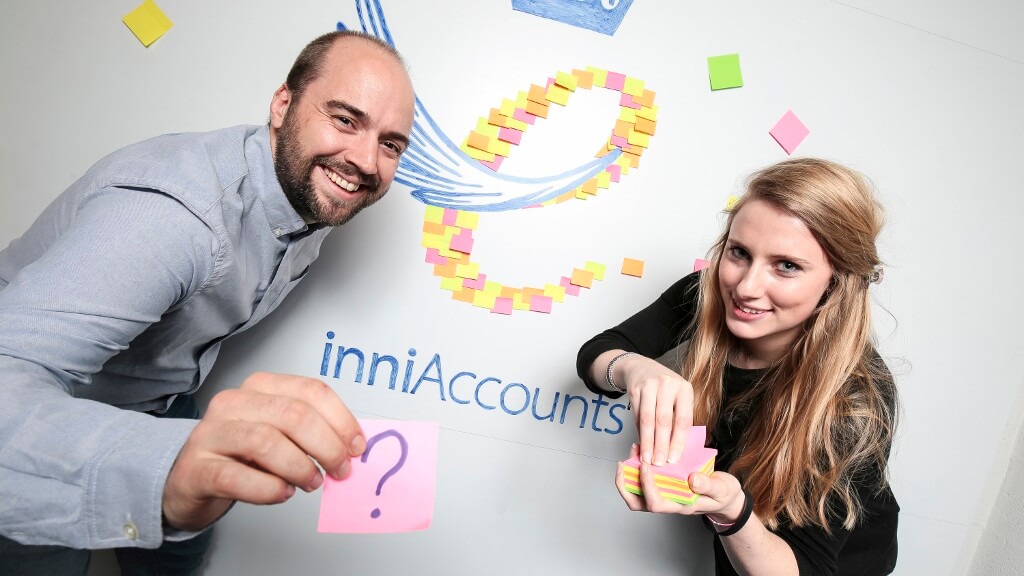InniAccounts turned over £1m this year. Co-founder James Poyser gives three key reasons it achieved this glorious milestone.
How We Made It To A Million, In Three Tips
InniAccounts turned over £1m this year. Co-founder James Poyser gives three key reasons it achieved this glorious milestone.

It’s taken 10 years, but this year we have hit one almighty milestone: the company I founded with my brother and friend is now turning over £1million.
Sometimes I have to pinch myself that we did it. The idea we had sitting in a kitchen now employs 30 people, helps thousands of people run their business and creates profit we plough back into the company.
But being totally self-funded, means we’ve had to go at a different rate to other tech start-ups. It was a conscious decision to bootstrap as much as we could because we believed it would give us total control.
And it has, but it has come at as a price. Self-funding means you put yourself in a virtual straight-jacket and can’t always grow as fast as you want or need to. Along the way I’ve had to adjust my goals numerous times and there are three things I would tell myself if I started it all again.
Do what the text books say and have a vision
Our ultimate goal was to create a real-time accounting service. It’s a goal that comes with huge technical complexity and achieving it was a labour of love. It took years.
We used all our experience of using accounting services to inform how we developed an online tool to do it for you. Then we got customers and things started to change. We got side tracked by requests. We said yes to customers and prospects who asked for things. Before long we were running off in tangents to keep people happy and we lost sight of the vision.
It became a never-ending circle; make a change in response to customer feedback, launch it, get more feedback, refine it. Sometimes this was great because the ideas were central to our raison d’être. Other times it was a total distraction and we wondered why we started it. The truth be told, we were crowd pleasers. We wanted to keep customers happy so we could never say no.
As it happens customer experience and satisfaction is what sets us apart from our competitors. However, you must acknowledge when keeping everyone happy starts to erode your success.
So my advice is this: If you have to rip the page on company visions out of the text book and stick it on the wall then do it. Have a vision. Look at it every day. Stick with it.

Keep your eyes on the prize
Recognise distractions can make you as well as break you
We moved away from keeping everyone happy a few years ago. It made a huge difference to our delivery rate as we focused on the things that we believed would really make a difference to our product and therefore our rate of retention and acquisition.
Plus, all the time we freed up was invested into customer service. A big tick for staying focused and keeping people happy.
However, we didn’t stop listening. That’s because occasionally, an idea we were given was actually a game changer for the business and the industry. Instead we created a log of all the ideas we received and categorised them according to ease of execution and value to the company and our vision, and our customers.
Very often the most difficult to deliver were the ones that would have the most impact, and if we approached them in the right way we could very easily incorporate smaller ideas. In other words we could kill several birds with one profitable stone.
A good example is the feedback we received on expenses. Even we admit it was a tiresome task. Initially we thought we could solve it by shortening the process and making a few cosmetic changes to alleviate some of the pain. It was an OK solution.
Around the same time we were exploring artificial intelligence and it became obvious that we could go one better on improving the usability of the expense tool and actually automate how expenses were categorised. So we did.
It took a while to get there but not only did we surpass the customer expectations, we had created a live test bed for our dev team. We learnt so much from undertaking this approach and today it informs our more ambitious AI projects.
It was a turning point and validates why it’s so important to invest in the big things and do them brilliantly so you can help the majority not the few.

Investing in big ideas can bring about dramatic results
Develop your decision making compass
I mentioned that we started to evaluate ideas according to their value. That’s something that’s very easy to do when you have a product you want to improve. But there are plenty of other business decisions that can stand in your way.
For instance you can be rolling along nicely and a competitor will change their pricing, the government will change the tax structure, or a crucial employee leaves. This can really put you in a tailspin.
In fact, I would sat that in terms of managing problems most owner managers get an A* for delivery, but if you assessed us on hitting the overall business goal and pushing the vision we’d get –C.
It’s a tough place to find yourself and to help I decided to go back to school. Joining the Goldman Sachs 10k small business programme helped me to re-evaluate my role in the company and our vision. At the end of it I could identify how I should prioritise goals and how I should fulfill them, and most importantly, determine if someone else needed to fulfill them.
I’ve fine tuned my compass for decision making and it’s taken away a lot of the pressure of the day to day admin, and helped me to focus on the big stuff that will keep the ship moving, while knowing the small stuff is looking after itself or being looked after.
When you combine this with a structured approach to prioritising projects it becomes very powerful. You can really shift things up a gear. For example, for a long time it’s helped us to justify why we shouldn’t invest in an Apple app. Despite the pent up demand it’s too costly to develop and too high risk to get it wrong. It’s a huge risk for a small company like ours.
However, now the technology is maturing we can change our position and develop something that excels for a quarter of the price. It’s a decision that though disliked (by us and customers) will now come good for us because we’ll have a high caliber app that people didn’t expect to come from a small outfit.
And I think that’s the greatest thing I have learnt; it takes guts to say no and disappoint people but if you keep listening and invest in the right things at the right time it will pay off big time both in revenue and reputation.
James Poyser is CEO and co-founder of inniAccounts.
Thanks for signing up to Minutehack alerts.
Brilliant editorials heading your way soon.
Okay, Thanks!


